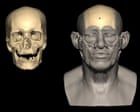
In a harmonious blend of technology and historical insight, the world witnesses groundbreaking advancements and discoveries across various fields. From the depths of ancient history to the forefront of artificial intelligence and space exploration, these developments paint a vivid picture of human curiosity and ingenuity.
In a fascinating blend of science and history, researchers have successfully conducted the first whole genome analysis of an ancient Egyptian skeleton. Uncovered over a century ago from a sealed pottery vessel in a tomb at Nuwayrat, located 165 miles south of Cairo, this skeleton belonged to a man from the dawn of the Age of the Pyramids, approximately 4,500 years ago. Historians speculate that he might have been a potter, with his bones bearing the marks of a life filled with hard labor.
The preservation of his remains within the sealed vessel has remarkably protected his DNA, allowing scientists to decode his entire genetic information. This achievement opens new pathways to understanding the genetic history of ancient peoples and provides richer insights into the daily lives, health, and movements of those who lived thousands of years ago. The DNA analysis not only sheds light on this individual’s life but also serves as a cornerstone for further research into ancient Egyptian civilization, offering a unique glimpse into an era that remains shrouded in mystery for most of us today.
On a different frontier, in the realm of robotics and artificial intelligence, China hosted its first fully autonomous AI robot football match in Beijing. This event marked an exciting step forward in the development of artificial intelligence, despite some of the humorous challenges the robots faced. The competition featured teams of humanoid robots engaging in three-a-side matches. While the robots occasionally struggled with basic tasks such as kicking and maintaining balance, their participation symbolizes significant progress in robotic engineering and AI integration.
These matches, while modest in their current display of skills, highlight the future potential of AI and robotics. Developers continue to fine-tune these machines, aiming for improvements in coordination, agility, and decision-making. Such advancements could pave the way for robots playing more dynamic roles in fields beyond entertainment, such as automation, search and rescue operations, and even daily companionship.
In another sphere, France is stepping up its efforts in space surveillance. The collaboration between major aerospace companies like ArianeGroup and Safran, together with emerging start-ups, marks a significant move towards enhancing space surveillance capabilities. With a rapidly growing number of satellites and other space-related activities, the French initiative is crucial for monitoring space debris and ensuring the sustainable use of outer space, a notion largely reliant on U.S. endeavors to date.
This strategic enhancement aims to bolster France’s autonomy in space management and contribute to global efforts to keep space activities safe and sustainable. By developing sophisticated systems capable of tracking and analyzing satellite movements and potential hazards in space, these initiatives reflect a broader trend: the increasing importance of space as a domain of both opportunity and responsibility.
Together, these varied developments emphasize our collective quest to explore and innovate, bridging gaps between the past and the future. Whether unraveling the genetic codes of ancient civilizations, harnessing AI to create autonomous entities, or strengthening our gaze upon the cosmos, humanity’s ongoing journey is filled with the promise of new knowledge, underscoring the boundless potential of current and forthcoming discoveries.
Source: {link}
